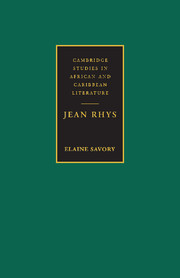Book contents
- Frontmatter
- Contents
- Preface
- Acknowledgements
- List of abbreviations and note on the text
- Chronology
- 1 Living on both sides, living to write
- 2 Registering protest: The Left Bank and Quartet
- 3 A Caribbean woman lost in Europe?: After Leaving Mr MacKenzie and the question of gender
- 4 Writing colour, writing Caribbean: Voyage in the Dark and the politics of colour
- 5 Dangerous spirit, bitterly amused: Good Morning, Midnight
- 6 People in and out of place: spatial arrangements in Wide Sargasso Sea
- 7 Brief encounters: Rhys and the craft of the short story
- 8 Performance arts: the theatre of autobiography and the role of the personal essay
- 9 The Helen of our wars: cultural politics and Jean Rhys criticism
- Notes
- Select bibliography
- Index
1 - Living on both sides, living to write
Published online by Cambridge University Press: 22 September 2009
- Frontmatter
- Contents
- Preface
- Acknowledgements
- List of abbreviations and note on the text
- Chronology
- 1 Living on both sides, living to write
- 2 Registering protest: The Left Bank and Quartet
- 3 A Caribbean woman lost in Europe?: After Leaving Mr MacKenzie and the question of gender
- 4 Writing colour, writing Caribbean: Voyage in the Dark and the politics of colour
- 5 Dangerous spirit, bitterly amused: Good Morning, Midnight
- 6 People in and out of place: spatial arrangements in Wide Sargasso Sea
- 7 Brief encounters: Rhys and the craft of the short story
- 8 Performance arts: the theatre of autobiography and the role of the personal essay
- 9 The Helen of our wars: cultural politics and Jean Rhys criticism
- Notes
- Select bibliography
- Index
Summary
With this eye I see & no other … I had two longings & one was fighting the other.
I wanted to be loved & I wanted to be always alone.
(GEB)It is crucially important to explore the contexts of Rhys's work, especially her placement of the role of writing in her life and of race, class, nationality, gender and religion. She was interestingly contradictory on these subjects, and inclined therefore to tell a story which was Janus-faced, capable of capturing opposing readings of the world which usually failed to communicate well with one another.
Rhys had a well-developed instinct for the submerged pattern within the raw material of life, she also, as a writer, created her own history, not only in her autobiography, but less guardedly in letters and fragments of unfinished autobiographical manuscript. Emotional honesty was her touchstone, selectivity and clarity her writing mantras. Honesty does not mean disclosure has to be complete: selectivity does not mean anything important has to be left out. Rhys chose to tell a very edited version of her life in Smile Please (1979) and left, in her will, an injunction against anyone writing her biography: she wanted to insist that attention be paid only to the work. There were clearly episodes in her life which she preferred not to discuss and which she argued were irrelevant to her literary achievement.
- Type
- Chapter
- Information
- Jean Rhys , pp. 1 - 35Publisher: Cambridge University PressPrint publication year: 1999



